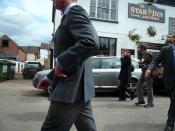Boyle's Law
In the 1700's a number of people investigated gas behavior in the laboratory. Robert Boyle investigated the relationship between the volume of a dry ideal gas and its pressure. Since there are four variables that can be altered in a gas sample, in order to investigate how one variable will affect another, all other variables must be held constant or fixed. Boyle fixed the amount of gas and its temperature during his investigation. He found that when he manipulated the pressure that the volume responded in the opposite direction. For example, when Boyle increased the pressure on a gas sample the volume would decrease. Mathematically, PV = constant value if the gas is behaving as an Ideal Gas. A practical math expression of Boyle's findings is as follows:
P1V1 = P2V2
where the variables with the 1 subscript mean initial values before the manipulation and the variables with the 2 subscript mean final values after the manipulation.
Charles's Law
Jacques Charles investigated the relationship between the Volume of a gas and how it changes with temperature. He noted that the volume of a gas increased with the temperature. Charles's Law states that the volume of a given amount of dry ideal gas is directly proportional to the Kelvin Temperature provided the amount of gas and the pressure remain fixed. When we plot the Volume of a gas against the Kelvin temperature it forms a straight line. The mathematical statement is that the V / T = a constant. For two sets of conditions the following is a math statement of Charles's Law:
V1 / T1 = V2 / T2
Gay-Lussac Law
Gay-Lussac investigated the relationship between the Pressure of a gas and its temperature. At constant Volume, the pressure of a gas sample is directly proportional to the...


![[The Voisin brothers, French aviation pioneers. Gabriel Voisin (1880-1973), on the left, and Charles Voisin (1882-1912), on the right] (LOC)](https://s.writework.com/uploads/5/50179/voisin-brothers-french-aviation-pioneers-gabriel-voisin-188-thumb.jpg)